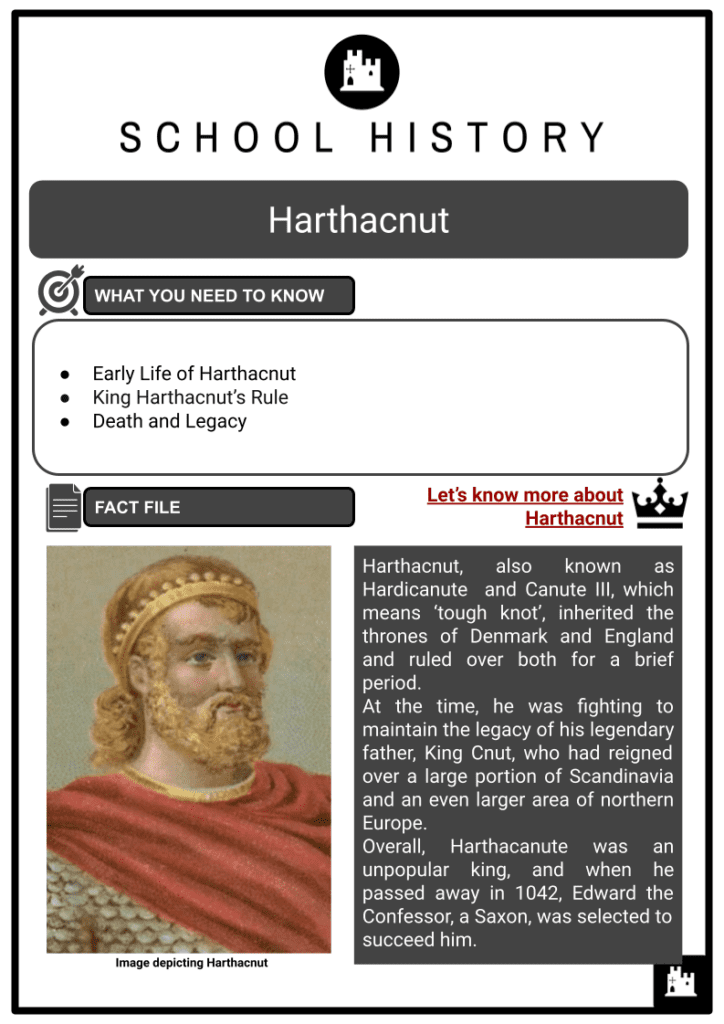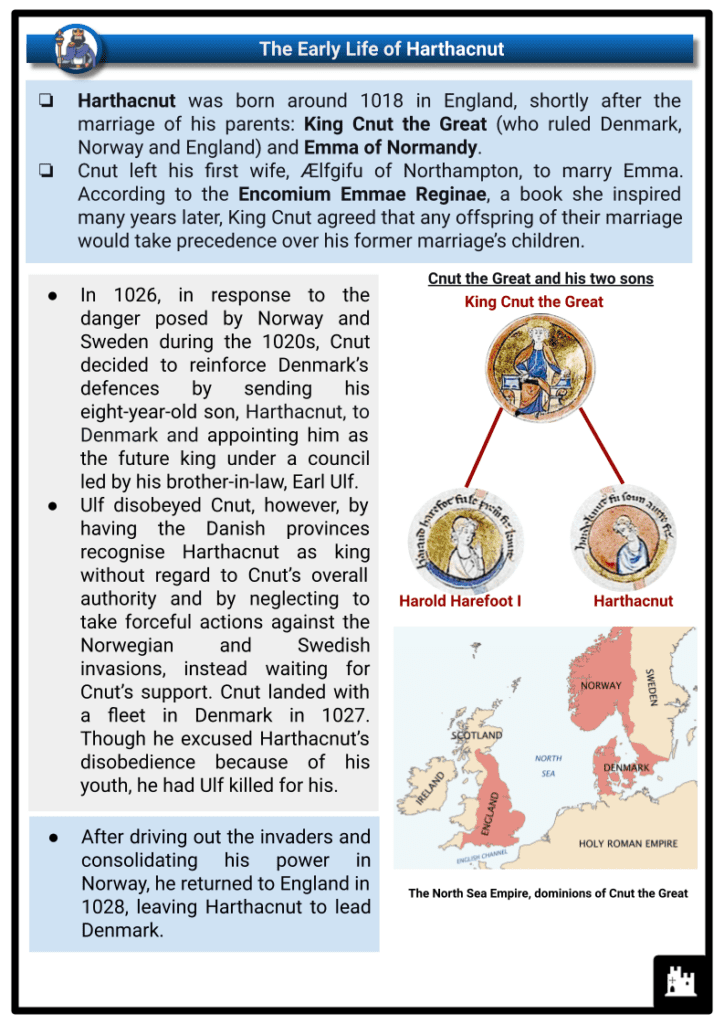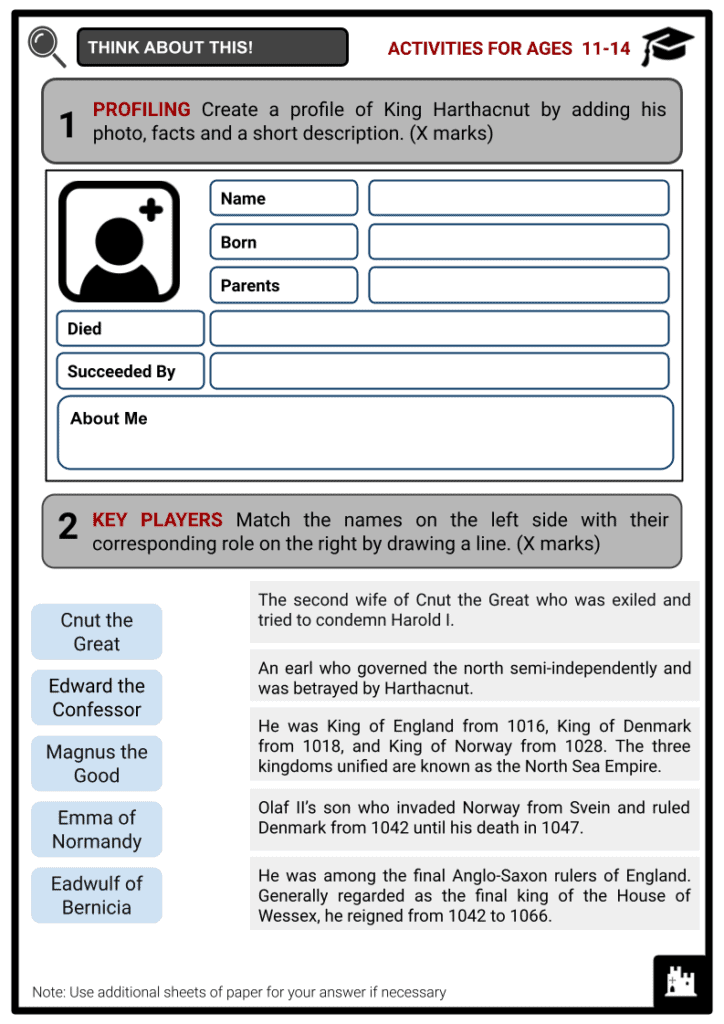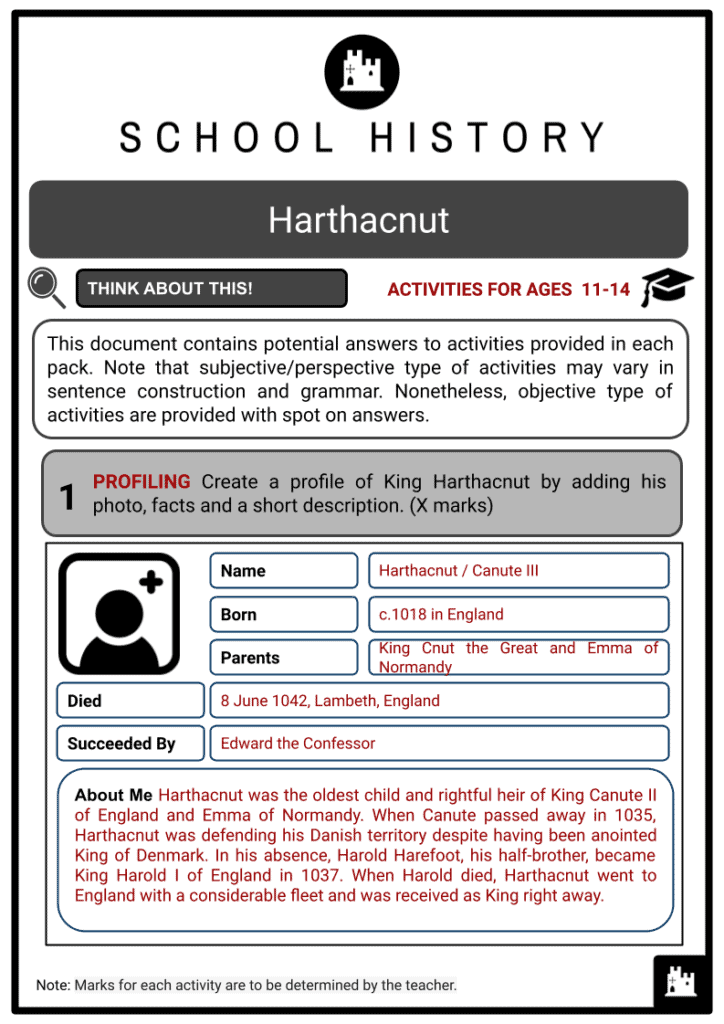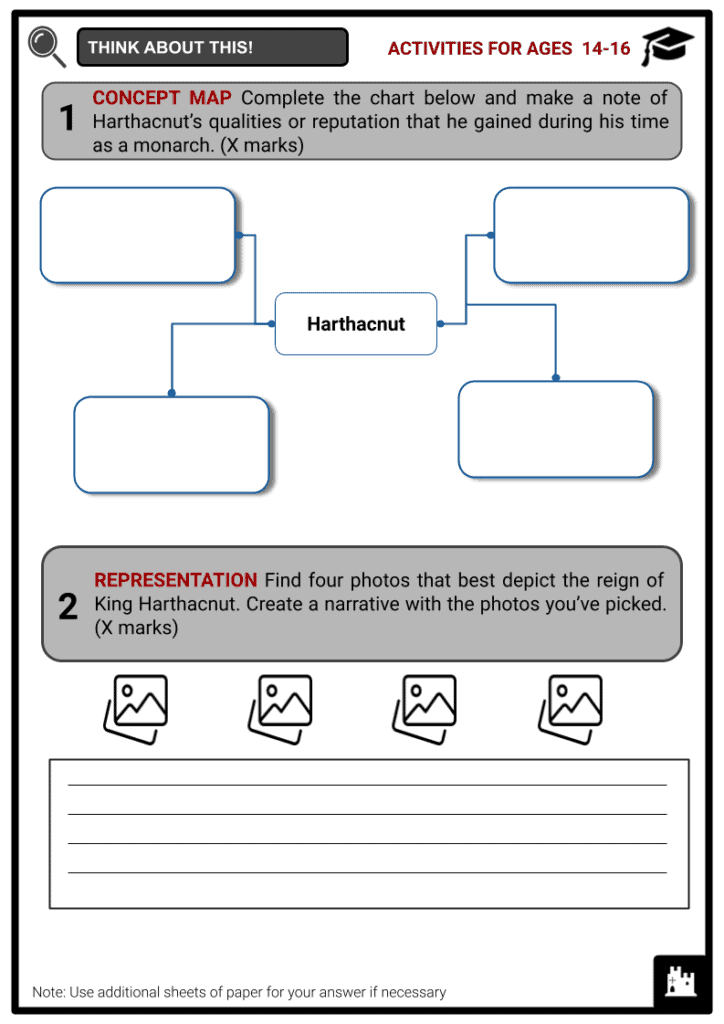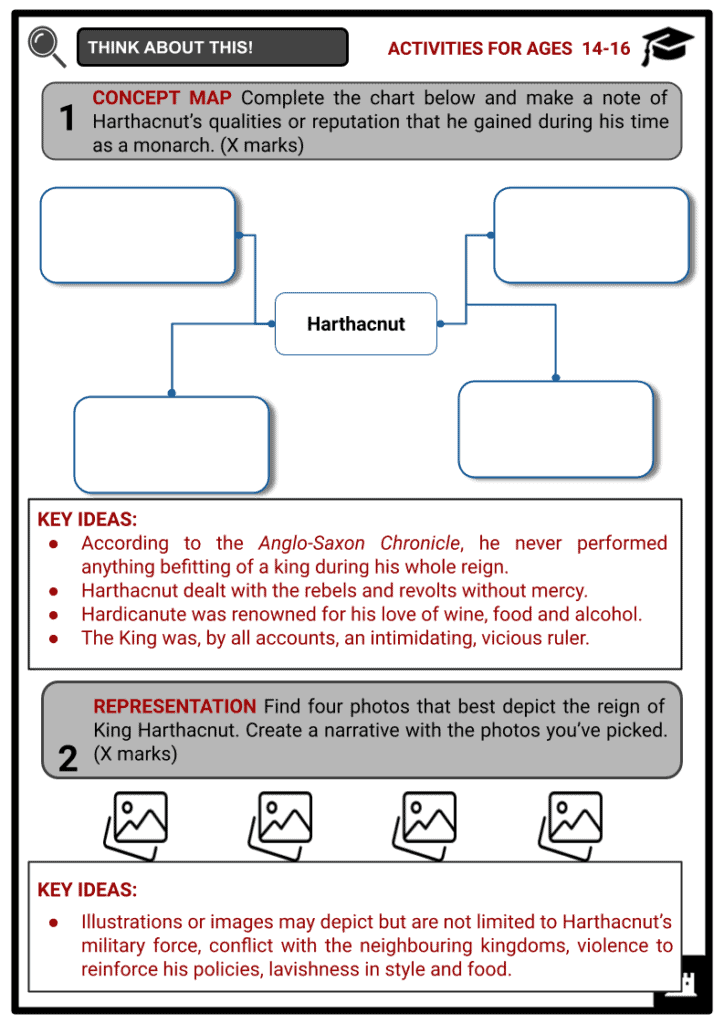Harthacnut Worksheets
Do you want to save dozens of hours in time? Get your evenings and weekends back? Be able to teach about Harthacnut to your students?
Our worksheet bundle includes a fact file and printable worksheets and student activities. Perfect for both the classroom and homeschooling!
Summary
- Early Life of Harthacnut
- King Harthacnut’s Rule
- Death and Legacy
Key Facts And Information
Let’s find out more about Harthacnut!
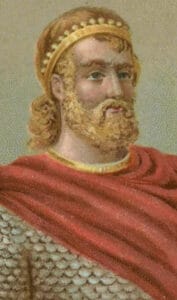
Harthacnut, also known as Hardicanute and Canute III, which means ‘tough knot’, inherited the thrones of Denmark and England and ruled over both for a brief period. At the time, he was fighting to maintain the legacy of his legendary father, King Cnut, who had reigned over a large portion of Scandinavia and an even larger area of northern Europe. Overall, Harthacanute was an unpopular king, and when he passed away in 1042, Edward the Confessor, a Saxon, was selected to succeed him.
The Early Life of Harthacnut
- Harthacnut was born around 1018 in England, shortly after the marriage of his parents: King Cnut the Great (who ruled Denmark, Norway and England) and Emma of Normandy.
- Cnut left his first wife, Ælfgifu of Northampton, to marry Emma. According to the Encomium Emmae Reginae, a book she inspired many years later, King Cnut agreed that any offspring of their marriage would take precedence over his former marriage’s children.
- In 1026, in response to the danger posed by Norway and Sweden during the 1020s, Cnut decided to reinforce Denmark’s defences by sending his eight-year-old son, Harthacnut, to Denmark and appointing him as the future king under a council led by his brother-in-law, Earl Ulf.
- Ulf disobeyed Cnut, however, by having the Danish provinces recognise Harthacnut as king without regard to Cnut’s overall authority and by neglecting to take forceful actions against the Norwegian and Swedish invasions, instead waiting for Cnut’s support. Cnut landed with a fleet in Denmark in 1027. Though he excused Harthacnut’s disobedience because of his youth, he had Ulf killed for his.
- After driving out the invaders and consolidating his power in Norway, he returned to England in 1028, leaving Harthacnut to lead Denmark.
- Cnut departed Norway during the reign of Håkon Eiriksson, who perished in a shipwreck in 1029 or 1030. Cnut then selected his son Svein Knutsson to rule Norway with the help of his first wife and Svein’s mother, Ælfgifu.
- When Magnus the Good (the son of the former King of Norway, Olaf) invaded Norway in 1035, Svein was compelled to escape to Harthacnut’s court because they had made themselves unpopular via severe taxes and favouring Danish counsel over the Norwegian nobility.
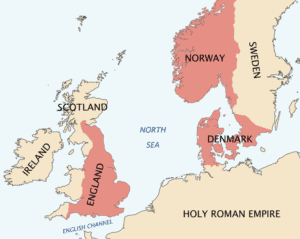
The North Sea Empire, dominions of Cnut the Great - Magnus I, sometimes known as Magnus the Good, ruled Denmark from 1042 until his death in 1047. He reigned as King of Norway from 1035 to 1047. When Olaf II of Norway was deposed in 1028, Magnus, who was Olaf’s illegitimate son, escaped with his mother Alfhild. In 1035, when he returned to Norway, he was made King at the young age of 11. He was also made King of Denmark in 1042.
- Harthacnut was Svein’s close ally, but he didn’t think he had enough resources to invade Norway. When the half-brothers turned to their father for support in 1035, they learned of his death instead.
- Harthacnut promised to assist Svein in reclaiming Norway and prepared an attack in 1036; unfortunately, Svein perished shortly thereafter.
King Harthacnut’s Rule
Succession
- After his father passed away in 1035, Harthacnut ascended to the throne of Denmark.
- Because of his engagement in a conflict with King Magnus I of Norway, Harthacnut was unable to establish his rightful claim to the throne of England. Meanwhile, Harthacnut’s brother Harold I Harefoot seized Harthacnut’s position as King of England.
- Harold was widely recognised as King in 1037, with Harthacnut being forsaken because he spent too long in Denmark, according to the words of the Anglo-Saxon Chronicle and Emma escaping to Bruges in Flanders.
- Emma, who was exiled in Bruges, conspired to secure the English crown for her son. She financed the Encomium Emmae Reginae, which praised her and condemned Harold I, particularly for organising the 1036 murder of Alfred Atheling, the younger of Emma’s two sons with Æthelred.
- The piece portrays Harthacnut’s anguish at learning of his half-brother’s murder and, in Ian Howard’s estimation, was likely
instrumental in persuading the hesitant King to invade England. - Harthacnut and Magnus I of Norway avoided war and reached a treaty in 1038 through a contract that stipulated that if either died without a successor, the opponent would become his heir.
- Harthacnut likely consented to this compromise because he lacked a realistic rival for the throne of Norway and was personally motivated to avoid a war.
- When it became apparent that Harold was gravely ill in England and would soon die, in March 1040, Harthacnut went with ten ships to meet his mother at Bruges. It didn’t take long for envoys to cross the canal and present Harthacnut with an offer of the throne.
Back in England
- Harthacnut travelled with his mother to England. Even though he brought 62 warships, his landing at Sandwich on 17 June 1040, seven days before Midsummer, was peaceful. Even though he had been asked to ascend the throne, he took no chances and arrived with an invading army as a conqueror.
- Midsummer is a celebration of summer that is often held around the summer solstice. It has pre-Christian, pagan origins in Europe. The unified Christian Church established 24 June as the feast day of the early Christian martyr St John the Baptist, and the celebration of St John’s Day begins the evening before, which is known as St John’s Eve.
- Harthacnut ascended the English throne on 17 March 1040 at Canterbury Cathedral, at the age of 22.
- To compensate the crews for their work, he levied a tax of more than 21,000 pounds, a figure so large that it made him unpopular, despite the fact that it was just a fifth of the amount his father had collected under similar circumstances in 1017–1018.
- Many in England hoped that Canute’s righteous reign would be re-established, but they were sorely mistaken.
- The death of Alfred by Harold had appalled Harthacnut, and his mother sought retribution. Harold’s body was exhumed from its place of honour at Westminster and publicly beheaded with the permission of his former councillors.
- It was thrown into a sewer but later recovered and tossed into the Thames, where London shipmen recovered it and buried it in a churchyard.
- Godwin, the renowned Earl of Wessex, was prosecuted in a trial before Harthacnut and members of his council for his complicity in the crime, as he had given up Alfred to Harold.
- The King permitted Godwin to avoid punishment by presenting evidence that he had acted on Harold’s orders.
- Godwin subsequently gave Harthacnut a ship so lavishly adorned that it was worth as much as the compensation that Godwin would have had to pay if he had been found guilty.
- Bishop Lyfing of Worcester was accused of involvement and removed from his position, but after making amends with Harthacnut in 1041, he was reinstated.
During his reign
- Harthacnut was remembered for his brutality and intense vindictiveness. The English had become accustomed to a king reigning with the assistance of a council. However, Hardicanute had ruled Denmark autocratically and refused to adapt his ways, nor trust the leading Earls.
- His reign was immensely unpopular mainly because of the heavy taxes he imposed on the English people. He expanded the strength of the English fleet from 16 to 32 ships, which enabled him to have a force that could address troubles elsewhere in his empire. However, to pay for it, he significantly increased the tax rate.
- The surge occurred at the same time as a poor harvest, inflicting extreme suffering. In 1041, two of his tax collectors were so severe with the people in and around Worcester that there was a disturbance, and the tax collectors were murdered. As a response, Harthacnut imposed the then legal but extremely hated punishment known as ‘harrying’. He commanded his earls to destroy the city and slaughter its inhabitants.
- Siward was Earl of Northumbria, but Eadwulf of Bernicia governed the north semi-independently, which infuriated Harthacnut. Earl Eadwulf offended the King in 1041, then sought reconciliation. Harthacnut promised him safe conduct but later conspired with Siward to kill Eadwulf, who became Lord of Northumbria. The Anglo-Saxon Chronicle called the King’s action a ‘betrayal’ and an ‘oath-breaker’.
- Harthacnut was charitable towards the church. A royal charter of his handed territory to Bishop Ælfwine of Winchester, and he made additional donations to Ramsey Abbey. The Ramsey Chronicle from the 12th century praises his kindness and character.
Death and Legacy
Death
- Even before he became King of England, Harthacnut was afflicted with episodes of illness. Possibly suffering from tuberculosis, he was presumably aware that he did not have long to live.
- In 1041, he summoned his half-brother Edward the Confessor back from exile in Normandy and likely declared him his successor. Edward was his mother Emma’s son with Æthelred the Unready.
- Emma, who intended to maintain her authority by insuring that one of her sons was followed by another, may have influenced him. Harthacnut was unmarried and was not known to have had any children.
- Harthacnut attended a wedding at Lambeth on 8 June 1042. The groom was Tovi the Proud, Cnut’s former standard bearer, and the bride was Gytha, daughter of the courtier Osgod Clapa.
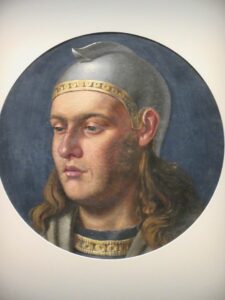
Christen Nielsen Overgaard’s painting of Harthacnut - Harthacnut likely consumed copious amounts of booze. As he drank to the bride’s health, he ‘died as he stood at his drink, and he shortly fell to the ground with a terrible convulsion; and those who were close to him seized hold of him, and he never spoke again’. The probable cause of death was a stroke ‘caused by heavy alcohol use’.
- Edward the Confessor was among the final Anglo-Saxon rulers of England. Generally regarded as the final king of the House of Wessex, he reigned from 1042 to 1066.
- In the Morkinskinna (13th-century Old Norse kings’ saga), Harthacnut’s death is contradicted. Magnus I of Norway (reigned 1034–1047) visited Harthacnut’s court in Denmark and was honoured.
- Ælfgifu of Northampton welcomed Magnus, and his drink was poured, but Harthacnut was offered to drink first by the guest. The poisoned drinking horn killed him. Ælfgifu attempted to poison Magnus but accidentally killed Harthacnut instead. He evaded punishment. The story is most likely a tale.
Legacy
- According to the Anglo-Saxon Chronicle, throughout his reign, he ‘did nothing befitting of a king’. Historians today are less contemptuous. According to M K Lawson, he possessed at least two characteristics of a successful mediaeval king: he was ‘both cruel and feared’; had he lived longer, the Norman Conquest may not have occurred.
- Ian Howard commends Harthacnut for maintaining peace across his dominion, promoting commerce and merchants, and securing a smooth transition by bringing his successor Edward to his court. Howard feels that his character would have enabled him to become a successful monarch like his father had he lived longer.
- Henry of Huntingdon, an English historian from the 12th century, said that Harthacnut insisted on having two dinners and two suppers daily. In his opinion, Harthacnut was more kind than other people of his time since the monarch shared these meals with the members of his household.
- The same information was perceived negatively by Ranulf Higden, a 14th-century English chronicler. His example impacted the English, who were allegedly gluttonous and opulent.
- According to Higden, Harthacnut has had an enduring impact on the English national character. The link between Harthacnut and gluttony was well known enough for Walter Scott to use it in his 1819 book Ivanhoe.
Successor
- According to the Heimskringla, an Old Norse kings’ saga, when Harthacnut died, Magnus made his claim to England because of the treaty that stipulated that if one of them died without an heir, the other would inherit his kingdom. He allegedly wrote a letter to Edward the Confessor claiming the English crown and threatening an invasion.
- Harald Hardrada would also advocate for this position. Both believed themselves to be legitimate successors of Harthacnut.
- From 1041, Edward the Confessor was co-ruler of England, according to the Encomium. In imitation of the Holy Trinity, there is a focus on Harthacnut, Edward and Emma serving as a ruling trinity. By surviving his co-ruler, Edward would become King by default.

